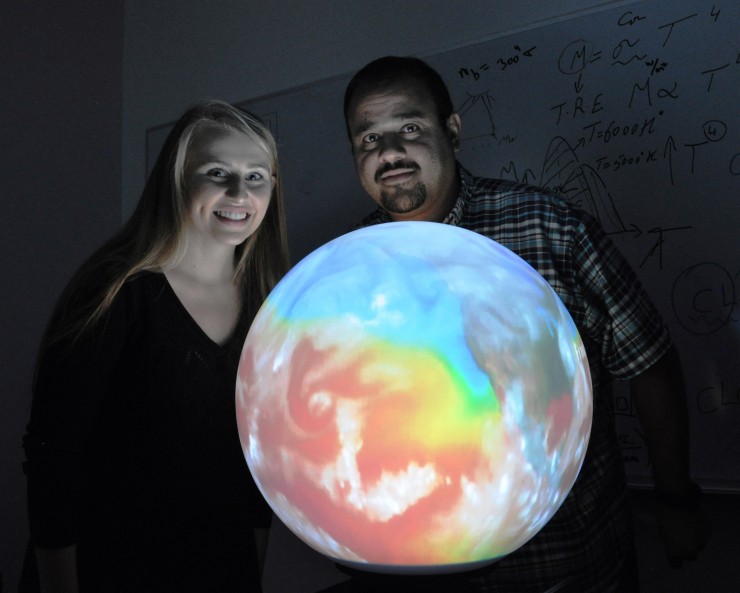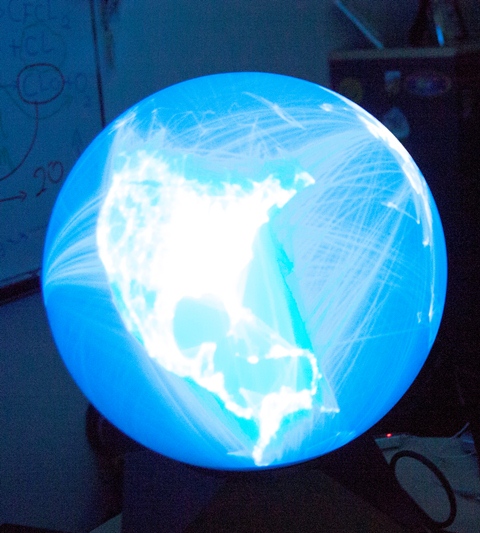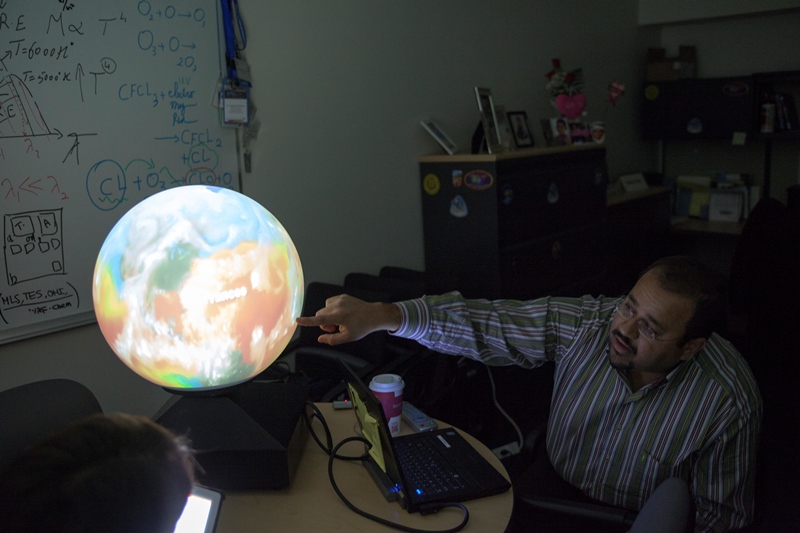The stories behind those trinkets, artworks and mementos in faculty offices won’t show up on their CVs. But the things faculty collect help us see another side of their academic lives. This month in Office Ours we check out the digital globe in the faculty office of Hesham El-Askary, Ph.D. Please send your Office Ours suggestions to pr@chapman.edu.
It’s not surprising that someone who studies global climate change might have a pretty cool globe in his office, even one that can be illuminated like a big glowing nightlight.
But here’s the thing about the globe in the office of Hesham El-Askary, Ph.D., associate professor in the Schmid College of Science and Technology. With the click of a keystroke, it comes to digital life.

Krista Rasmussen ’15 is one of the students working on climate change research with Professor Hesham El-Askary. The complex Earth systems, key to the research, are portrayed in El-Askary’s digital video globe.
As the globe rotates on its stand, El-Askary steps to his laptop to call up a variety of video images for a short tour of the globe’s animations. He starts with the classic cloud-dappled blue marble spinning on its axis. He switches that out for a view of global Facebook activity — Europe and the United States glow, while China falls dark. Then he opens an image of the world’s oceans, with all their currents in motion. The currents, shown in various colors that reflect their surface temperatures, swirl around the globe like rivers of Technicolor syrup.
But don’t break out the tie-dye T-shirts. This shiny sphere is not a thing of whimsy, but a valuable teaching tool that helps El-Askary explain climate change science, a field in which he is a widely published expert. The globe is called a Magic Planet and is manufactured by Global Imagination of Santa Clara, Calif. It’s similar in function to larger versions seen in science museums, but at 24 inches in diameter, El-Askary’s version is more portable. It’s a handy feature for a professor often called upon to explain to climate science to non-scientists.
“Visuals always bring life to whatever you are talking about,” El-Askary says, nodding toward the globe. “So when I talk about global climate change, when I talk about Earth system science and I show these kinds of visuals … it adds weight.”
El-Askary researches extreme natural events in the atmosphere and hydrosphere. His work seeks to understand how disruptions in these systems can lead to massive storms like Hurricane Sandy, persistent drought and devastation of coral reefs. The globe helps viewers understand the science behind his research because it so vividly demonstrates the interconnectedness of the Earth’s systems, from the atmosphere overhead to the biosphere underfoot.
“Each of these systems can be seen. People think of them as departments, distinct and separate. But they are not. All of these subsystems are in coherency with one another. They are interacting continuously with one another,” he says.

Earth systems aren’t the only things that are interconnected on the planet. For fun, El-Askary displays an image that reflects Facebook activity.
The globe can also be animated with real-time satellite imagery, so it’s even useful in El-Askary’s undergraduate courses on hazards and global environmental issues.
“We can go live,” he says. “This is a three-dimensional data show.”
But one of his favorite tricks when speaking to youngsters at the Orange City Library or Nicholas Learning Centers is to switch the video projection to a single, creepy eye looking out at the audience.
“They laugh. But I get their attention,” he says.
And that is his main goal whenever he talks about climate change. Says El-Askary: “We are all part of one big system, which is made up of different interacting subsystems. And once there is harm done to any of those interacting subsystems, the impact is going to reach all of us wherever we are.”
Read more about El-Askary’s research in Chapman Magazine.





Add comment